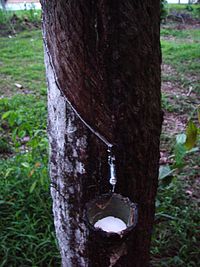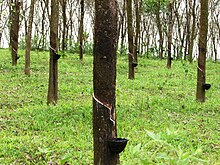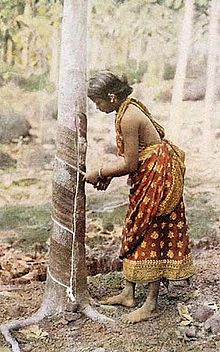Natural rubber
This article needs additional citations for verification. (February 2008) |

Natural rubber is an elastomer (an elastic hydrocarbon polymer) that was originally derived from a milky colloidal suspension, or latex, found in the sap of some plants. The purified form of natural rubber is the chemical polyisoprene, which can also be produced synthetically. Natural rubber is used extensively in many applications and products as is synthetic rubber.
Varieties
The major commercial source of natural rubber latex is the Para rubber tree (Hevea brasiliensis), a member of the spurge family, Euphorbiaceae. This is largely because it responds to wounding by producing more latex.
Other plants containing latex include Gutta-Percha (Palaquium gutta),[1] rubber fig (Ficus elastica), Panama rubber tree (Castilla elastica), spurges (Euphorbia spp.), lettuce, common dandelion (Taraxacum officinale), Russian dandelion (Taraxacum kok-saghyz), Scorzonera tau-saghyz, and Guayule (Parthenium argentatum). Although these have not been major sources of rubber, Germany attempted to use some of these during World War II when it was cut off from rubber supplies[citation needed]. These attempts were later supplanted by the development of synthetic rubbers. To distinguish the tree-obtained version of natural rubber from the synthetic version, the term gum rubber is sometimes used.
Discovery of commercial potential
Charles Marie de La Condamine is credited with introducing samples of rubber to the Académie Royale des Sciences of France in 1736.[2] In 1751, he presented a paper by François Fresneau to the Académie (eventually published in 1755) which described many of the properties of rubber. This has been referred to as the first scientific paper on rubber.[2]
The para rubber tree initially grew in South America, and the first European to return to Portugal from Brazil with samples of water-repellent rubberized cloth so shocked people that he was brought to court on the charge of witchcraft. When samples of rubber first arrived in England, it was observed by Joseph Priestley, in 1770, that a piece of the material was extremely good for rubbing out pencil marks on paper, hence the name rubber.
South America remained the main source of what limited amount of latex rubber was consumed during much of the 19th century. However in 1876, Henry Wickham gathered thousands of seeds from Brazil, and these were germinated in Kew Gardens, UK. The seedlings were then sent to Ceylon (Sri Lanka), Indonesia, Singapore and British Malaya. Malaya (now Malaysia) was later to become the biggest producer of rubber. About 100 years ago, the Congo Free State in Africa was also a significant source of natural rubber latex, mostly gathered by forced labor. Liberia and Nigeria also started production of rubber.
In India, commercial cultivation of natural rubber was introduced by the British Planters, although the experimental efforts to grow rubber on a commercial scale in India were initiated as early as 1873 at the Botanical Gardens, Kolkata. The first commercial Hevea plantations in India were established at Thattekadu in Kerala in 1902.
Properties
Rubber exhibits unique physical and chemical properties. Rubber's stress-strain behavior exhibits the Mullins effect, the Payne effect and is often modeled as hyperelastic. Rubber strain crystallizes.
Owing to the presence of a double bond in each and every repeat unit, natural rubber is sensitive to ozone cracking.
Solvents
There are two main solvents for rubber: turpentine and naphtha (petroleum). The former has been in use since 1763 when Francois Fresnau made the discovery. Giovanni Fabronni is credited with the discovery of naphtha as a rubber solvent in 1779. Because rubber does not dissolve easily, the material is finely divided by shredding prior to its immersion.
An ammonia solution can be used to prevent the coagulation of raw latex while it is being transported from its collection site.
Chemical makeup
Natural rubber is a polymer of isoprene - most often cis-1,4-polyisoprene - with a molecular weight of 100,000 to 1,000,000. Typically, a few percent of other materials, such as proteins, fatty acids, resins and inorganic materials are found in natural rubber. Polyisoprene is also created synthetically, producing what is sometimes referred to as "synthetic natural rubber".
Some natural rubber sources called gutta percha are composed of trans-1,4-polyisoprene, a structural isomer which has similar, but not identical properties.
Natural rubber is an elastomer and a thermoplastic. However, it should be noted that as the rubber is vulcanized it will turn into a thermoset. Most rubber in everyday use is vulcanized to a point where it shares properties of both; i.e., if it is heated and cooled, it is degraded but not destroyed.
Elasticity
In most elastic materials, such as metals used in springs, the elastic behavior is caused by bond distortions. When force is applied, bond lengths deviate from the (minimum energy) equilibrium and strain energy is stored electrostatically. Rubber is often assumed to behave in the same way, but it turns out this is a poor description. Rubber is a curious material because, unlike metals, strain energy is stored thermally. Also, natural rubber is so elastic that when force is applied, on natural rubber when it is on a surface similar to carpet, it may be difficult to 'pull' across the surface.
In its relaxed state rubber consists of long, coiled-up polymer chains that are interlinked at a few points. Between a pair of links each monomer can rotate freely about its neighbour. This gives each section of chain leeway to assume a large number of geometries, like a very loose rope attached to a pair of fixed points. At room temperature rubber stores enough kinetic energy so that each section of chain oscillates chaotically, like the above piece of rope being shaken violently. The entropy model of rubber was developed in 1934 by Werner Kuhn.
When rubber is stretched the "loose pieces of rope" are taut and thus no longer able to oscillate. Their kinetic energy is given off as excess heat. Therefore, the entropy decreases when going from the relaxed to the stretched state, and it increases during relaxation. This change in entropy can also be explained by the fact that a tight section of chain can fold in fewer ways (W) than a loose section of chain, at a given temperature (nb. entropy is defined as S=k*ln(W)). Relaxation of a stretched rubber band is thus driven by an increase in entropy, and the force experienced is not electrostatic, rather it is a result of the thermal energy of the material being converted to kinetic energy. Rubber relaxation is endothermic, and for this reason the force exerted by a stretched piece of rubber increases with temperature (metals, for example, become softer as temperature increases). The material undergoes adiabatic cooling during contraction. This property of rubber can easily be verified by holding a stretched rubber band to your lips and relaxing it.
Stretching of a rubber band is in some ways equivalent to the compression of an ideal gas, and relaxation is equivalent to its expansion. Note that a compressed gas also exhibits "elastic" properties, for instance inside an inflated car tire. The fact that stretching is equivalent to compression may seem somewhat counter-intuitive, but it makes sense if rubber is viewed as a one-dimensional gas. Stretching reduces the "space" available to each section of chain.
Vulcanization of rubber creates more disulfide bonds between chains so it makes each free section of chain shorter. The result is that the chains tighten more quickly for a given length of strain. This increases the elastic force constant and makes rubber harder and less extendable.
When cooled below the glass transition temperature, the quasi-fluid chain segments "freeze" into fixed geometries and the rubber abruptly loses its elastic properties, though the process is reversible. This is a property it shares with most elastomers. At very cold temperatures rubber is actually rather brittle; it will break into shards when struck or stretched. This critical temperature is the reason that winter tires use a softer version of rubber than normal tires. The failing rubber o-ring seals that contributed to the cause of the Challenger disaster were thought to have cooled below their critical temperature. The disaster happened on an unusually cold day.
Current sources
Close to 21 million tons of rubber were produced in 2005 of which around 42% was natural. Since the bulk of the rubber produced is the synthetic variety which is derived from petroleum, the price of even natural rubber is determined to a very large extent by the prevailing global price of crude oil[citation needed]. Today Asia is the main source of natural rubber, accounting for around 94% of output in 2005. The three largest producing countries (Indonesia, Malaysia and Thailand) together account for around 72% of all natural rubber production.
Cultivation

Rubber latex is extracted from Rubber trees. The economic life period of rubber trees in plantations is around 32 years – up to 7 years of immature phase and about 25 years of productive phase.
The soil requirement of the plant is generally well-drained weathered soil consisting of laterite, lateritic types, sedimentary types, nonlateritic red or alluvial soils.
The climatic conditions for optimum growth of Rubber trees consist of (a) Rainfall of around 250 cm evenly distributed without any marked dry season and with at least 100 rainy days per annum (b) Temperature range of about 20°C to 34°C with a monthly mean of 25°C to 28°C (c) High atmospheric humidity of around 80% (d) Bright sunshine amounting to about 2000 hours per annum at the rate of 6 hours per day throughout the year and (e) Absence of strong winds.
Many high-yielding clones have been developed for commercial planting. These clones yield more than 2,000 kilograms of dry Rubber per hectare per annum, when grown under ideal conditions.
Collection

In places like Kerala, where coconuts are in abundance, the shell of half a coconut is used as the collection container for the latex but glazed pottery or aluminium cups are more common elsewhere. The cups are supported by a wire that encircles the tree.This wire incorporates a spring so that it can stretch as the tree grows. The latex is led into the cup by a galvanised "spout" that has been knocked into the bark. Tapping normally takes place early in the morning when the internal pressure of the tree is highest. A good tapper can tap a tree every 20 seconds on a standard half-spiral system and a common daily "task" size is between 450 and 650 trees. Trees are usually tapped alternate or third daily although there are many variations in timing, length and number of cuts. The latex, which contains 25 - 40% dry rubber, is in the bark so the tapper must avoid cutting right through to the wood or the growing cambial layer will be damaged and the renewing bark will be badly deformed making later tapping difficult. It is usual to tap a pannel at least twice, sometimes three times, during the trees' life. The economic life of the tree depends on how well the tapping is carried out as the critical factor is bark consumption. A standard in Malaysia for alternate daily tapping is 25 cm (vertical) bark consumption per annum. The latex tubes in the bark ascend in a spiral to the right. For this reason, tapping cuts usually ascend to the left to cut more tubes.
The trees will drip latex for about four hours, stopping as latex coagulates naturally on the tapping cut thus blocking the latex tubes in the bark. Tappers usually rest and have a meal after finishing their tapping work then start collecting the latex at about midday. Some trees will continue to drip after the collection and this leads to a small amount of cup lump which is collected at the next tapping. The latex that coagulates on the cut is also collected as tree lace. Tree lace and cup lump together account for 10 - 20% of the dry rubber produced.
The latex can be collected in its liquid state. It is sometimes necessary to add a few drops of ammonia solution to the cup, or to the transport tank, to prevent precoagulation of the latex before it reaches the factory. It can also be left in the cup to coagulate naturally into cup lump for collection before the next tapping, although this will produce a lower grade of product.
Latex is generally processed into either latex concentrate for manufacture of dipped goods or it can be coagulated under controlled, clean conditions using formic acid. The coagulated latex can then be processed into the higher grade technically specified block rubbers such as TSR3L or TSRCV or used to produce Ribbed Smoke Sheet grades.
Naturally coagulated rubber (cup lump) is used in the manufacture of TSR10 and TSR20 grade rubbers. The processing of the rubber for these grades is basically a size reduction and cleaning process in order to remove contamination and prepare the material for the final stage drying.
The dried material is then baled and palletized for shipment.
Uses
This article includes a list of references, related reading, or external links, but its sources remain unclear because it lacks inline citations. (April 2009) |

The use of rubber is widespread, ranging from household to industrial products, entering the production stream at the intermediate stage or as final products. Tires and tubes are the largest consumers of rubber, . The remaining 44% are taken up by the general rubber goods (GRG) sector, which includes all products except tires and tubes.
Pre-historical uses
The first use of rubber was natural latex from the Hevea Tree in 1600 BC by the Ancient Mayans[citation needed]. They boiled the harvested latex to make a ball for sport[citation needed].
Manufacturing
Other significant uses of rubber are door and window profiles, hoses, belts, matting, flooring and dampeners (anti-vibration mounts) for the automotive industry in what is known as the "under the bonnet" products. Gloves (medical, household and industrial) are also large consumers of toy balloons and rubber, although the type of rubber used is that of the concentrated latex. Significant tonnage of rubber is used as adhesives in many manufacturing industries and products, although the two most noticeable are the paper and the carpet industry. Rubber is also commonly used to make rubber bands and pencil erasers. The clothing brand 'Rip Curl' also uses natural rubber for thongs.
Textile applications
Additionally, rubber produced as a fiber sometimes called elastic, has significant value for use in the textile industry because of its excellent elongation and recovery properties. For these purposes, manufactured rubber fiber is made as either an extruded round fiber or rectangular fibers that are cut into strips from extruded film. Because of its low dye acceptance, feel and appearance, the rubber fiber is either covered by yarn of another fiber or directly woven with other yarns into the fabric. In the early 1900’s, for example, rubber yarns were used in foundation garments. While rubber is still used in textile manufacturing, its low tenacity limits its use in lightweight garments because latex lacks resistance to oxidizing agents and is damaged by aging, sunlight, oil, and perspiration. Seeking a way to address these shortcomings, the textile industry has turned to Neoprene (polymer form of Chloroprene), a type of synthetic rubber as well as another more commonly used elastomer fiber, spandex (also known as elastane), because of their superiority to rubber in both strength and durability.
Vulcanization
Natural rubber is often vulcanized, a process by which the rubber is heated and sulfur, peroxide or bisphenol are added to improve resilience and elasticity, and to prevent it from perishing. Vulcanization greatly improved the durability and utility of rubber from the 1830s on[citation needed]. The development of vulcanization is most closely associated with Charles Goodyear[3]. Carbon black is often used as an additive to rubber to improve its strength, especially in vehicle tires.
Allergic reactions
Some people have a serious latex allergy, and exposure to certain natural rubber latex products such as latex gloves can cause anaphylactic shock. Guayule latex is hypoallergenic and is being researched as a substitute to the allergy-inducing Hevea latexes. Unlike the sappable Hevea tree, these relatively small shrubs must be harvested whole and latex extracted from each cell.
Some allergic reactions are not from the latex but from residues of other ingredients used to process the latex into clothing, gloves, foam, etc. These allergies are usually referred to as multiple chemical sensitivity (MCS).
See also
- Akron, Ohio, center of the rubber industry
- Charles Greville Williams, researched natural rubber being a polymer of the monomer isoprene
- Elastomer
- Emulsion dispersion
- Fordlândia, failed attempt to establish a rubber plantation in Brazil
- Guayule, a useful, non-allergenic alternate source for Hevea derived natural rubber, native to North America
- Ozone cracking
- Rubber seed oil
- Resilin, a rubber sustitute
- Rubber tapping, the process of harvesting the rubber sap
- Rubber technology
- Stevenson Plan, historical British plan to stabilize rubber prices
References
- ^ Burns, Bill. "The Gutta Percha Company". History of the Atlantic Cable & Undersea Communications. Retrieved 2009-02-14.
- ^ a b Untitled Document
- ^ Slack, Charles. "Noble Obsession: Charles Goodyear,Thomas Hancock,and the Race to Unlock the Greatest Industrial Secret of the Nineteenth Century". Hyperion 2002. [ISBN-13: 9780786867899]
- Rubbery Materials and their Compounds by J.A Brydson
- Rubber Technology by Maurice Morton
Hobhouse, Henry (2003, 2005). Seeds of Wealth: Five Plants That Made Men Rich. Shoemaker & Hoard. pp. 125–185. ISBN 1-59376-089-2. {{cite book}}: Check date values in: |date= (help)
ashliegh is a sexbeast
